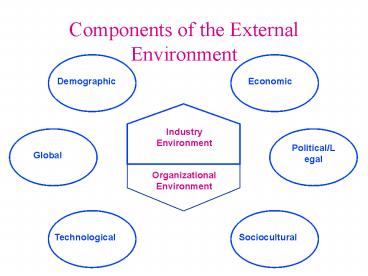Components of the External Environment - PowerPoint PPT Presentation
1 / 15
Title:
Components of the External Environment
Description:
... as all-out pursuit of the kids' market. ... geographic coverage (local, regional, ... National, Regional, & Local Guild - 'Fine Jewelry' Stores ... – PowerPoint PPT presentation
Number of Views:1578
Avg rating:3.0/5.0
Title: Components of the External Environment
1
Components of the External Environment
Demographic
Economic
Industry Environment
Political/Legal
Global
Organizational Environment
Technological
Sociocultural
2
Important Environmental Variables
Working Women Diversity Work Quality Career
expectations Lifestyle changes
Antitrust Laws Tax laws Deregulation
Environmental Foreign trade
3
Skill Building Exercise Participation Points!
- Two of the major competitors in the fast-food
industry---Wendys and McDonald's have positioned
themselves differently. Wendys has taken the
adult approach, practically ignoring the
childrens market with its advertising tie-ins
and toy giveaways. McDonalds has fashioned as
all-out pursuit of the kids market. Think about
demographic and sociocultural trends and changes.
- How would each organizations interpretation of
these trends and changes affect its choice of
strategy? - Which organization do you think is positioned
better for success in the local markets? Explain
your choice.
4
Porters Five Forces Model
Political and Legal Environment
Technological Environment
Potential Entrants
Threat of New Entrants
Industry Competitors -- Rivalry
Suppliers
Buyers
Bargaining Power of Suppliers
Bargaining Power of Buyers
Threat of Substitute products or services
Substitutes
Demographic Environment
Economic Environment
Global Environment
Sociocultural Environment
5
Porters Five Forces
6
Threat of Substitute Products
Keys to evaluate substitute products
Products with improving price/performance
tradeoffs relative to present industry products
Products with similar function limit the prices
firms can charge
Examples
Electronic security systems in place of security
guards
Fax machines in place of overnight mail delivery
7
Powerful Supplier
1. Few suppliers 2. Differentiated
products 3. No substitutes 4. Integration
possibilities 5. Small buyer 6. High switching
costs
8
Powerful Buyer
1. Large purchases 2. Low switching
costs 3. Undifferentiated products 4. Small
fraction of business 5. Integration possibilities
9
Rivalry
1. Numerous competitors 2. Slow industry
Growth 3. Undifferentiated products 4. High
fixed costs 5. Perishable products 6. Semivariab
le production capacity 7. High profit
potential 8. High exit barriers
10
Threat of New Entry--Entry Barriers
- Factors that make it difficult if not impossible
for other firms to enter a business - economies of scale
- product differentiation
- capital requirements
- switching costs
- access to distribution channels
- cost disadvantages independent of scale
- government policy
11
Characteristics of an Attractive Industry
- Threat of new entry is low (high entry barriers)
- buyer power is weak
- supplier power is weak
- no good substitutes exist
- rivalry is moderate
12
Analysis of Strategic Groups
- A strategic group consists of those rival firms
with similar competitive approaches and market
positions. - Rivalry within the group limits the profit
potential for all group members. - Changes in the external environment may hurt some
strategic groups and help others. - Mobility barriers may limit a firms ability to
move to a more profitable group.
13
Strategic Group Mapping
- Step 1 Identify the competitive characteristics
that differentiate firms in the industry.
Examples include - price/quality (high, medium, low)
- geographic coverage (local, regional, national,
global) - degree of vertical integration (none, partial,
full) - product line breath (wide, narrow)
- degree of service offered (No-frills, limited,
full service)
14
- Step 2 Plot the firms on a two-variable map
using pairs of these differentiating
characteristics. - Step 3 Assign firms that fall in about the same
strategy space to the same strategic group. - Step 4 Draw circles around each strategic
group, making the circles proportional to the
size of the groups respective share of total
industry sales revenues.
15
Example Strategic Group Map of Retail
Jewelry Industry
High
Small Independent Guild Jewelers
National, Regional, Local Guild - Fine
Jewelry Stores
Prestige Departmentalized Retailers
Upscale Department Stores
Price / Quality / Image
National Jewelry Chains Local Jewelers
Medium
Chains
Credit Jewelers
Catalog Showrooms Off-Price Retailers
Discounters
Outlet Mall Retailers
Low
Broad-category Retailers
Specialty Jewelers
Full-line Jewelers
Limited-category Retailers
Product Line / Merchandise Mix































